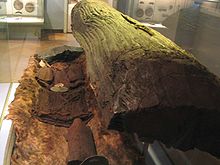Treetrunk coffin



A treetrunk coffin, hollowed out of a single massive log, is a feature of some prehistoric elite burials over a wide geographical range, especially in Northern Europe and as far east as the Balts, where cremation was abandoned about the 1st century CE, as well as in central Lithuania, where elites were also buried in treetrunk coffins.[1] The practice survived Christianization into the Middle Ages. The coffin in which the body of King Arthur, said to have been discovered at Glastonbury Abbey in 1191, was described by the contemporary chronicler Giraldus Cambrensis as being of a massive oak treetrunk. For Bronze Age Britain, examples have been recorded at Wydon Eals, near Haltwhistle, and at Cartington, Co. Durham,[2] in Scotland, Yorkshire, East Anglia (Liss, northeast Hampshire, for instance). In Yorkshire, "Gristhorpe Man",[3] a well-preserved human of the second millennium BCE, who was found 10 July 1834 under an ancient burial mound buried in a hollow oak tree trunk, is conserved at the Rotunda Museum, Scarborough: he was wrapped in an animal skin with a whalebone and bronze dagger and food for his journey. At the abbey of Munsterbilzen, Belgium, ten graves with massive treetrunk coffins were discovered in 2006.[citation needed]
Because hollowed trunks suggest dugout boats, such burials are sometimes described as boat burials. In Yanjinggou Developing Zone of Chengdu such a "boat burial" in a hollowed-out treetrunk found in 2006 was dated to the Warring States Era (475–221 BCE); it contained copper objects, bronze weapons, pottery and lacquer wares, seeds and peach pits. Its burial was the most recent of eight burials in coffins hollowed out of single tree trunks one and a half meters in diameter, five meters in length, with tapered ends bow and stern.
The phenomenon was not restricted to regions where massive timber was abundant. In Egypt, the conservation of a 1st-century cypresswood coffin hollowed from a single log, from a burial at Touna El Gebel, has been described.[4]
See also[]
Notes[]
- ^ Marija Gimbutas, The Balts (1963) ch. V, p. 112 (on-line text Archived October 17, 2006, at the Wayback Machine).
- ^ "The Cartington Early Bronze Age burial was discovered in 1913 during ploughing operations. Beneath a block of stone was found an oak "trough" or tree trunk coffin, 1.67m (5 ft 6 in) long and 0.5 to 0.63m (20 to 25 in) wide. Some teeth and a cast of a leg bone in the clay filling were all the human remains. Other items included fragments of stitched calfskin, a drinking cup, and a flint scraper. Radiocarbon dating gave a date range 2400-2200 BCE (on-line text). Archived 2007-10-07 at the Wayback Machine
- ^ "Gristhorpe Man: a Bronze Age warrior?"
- ^ Y. Zidan et al., "The conservation of a wooden Graeco-Roman coffin box"
- Ancient Egyptian technology
- Chinese inventions
- Coffins
- Death customs
- English inventions